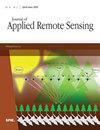Cercospora leaf spot detection in sugar beets using high spatio-temporal unmanned aerial vehicle imagery and unsupervised anomaly detection methods
IF 1.4
4区 地球科学
Q4 ENVIRONMENTAL SCIENCES
引用次数: 0
Abstract
Early disease detection is required, considering the impacts of diseases on crop yield. However, current methods involve labor-intensive data collection. Thus, unsupervised anomaly detection in time series imagery was proposed, requiring high-resolution unmanned aerial vehicle (UAV) imagery and sophisticated algorithms to identify unknown anomalies amidst complex data patterns to cope with within season crop monitoring and background challenges. The dataset used in this study was acquired by a Micasense Altum sensor on a DJI Matrice 210 UAV with a 4 mm resolution in Gottingen, Germany. The proposed methodology includes (1) date selection for finding the date sensitive to sugar beet changes, (2) vegetation index (VI) selection for finding the one sensitive to sugar beet and its temporal patterns by visual inspection, (3) sugar beet extraction using thresholding and morphological operator, and (4) an ensemble of bottom-up, Kernel, and quadratic discriminate analysis methods for unsupervised time series anomaly detection. The study highlighted the importance of the wide-dynamic-range VI and morphological filtering with time series trimming for accurate disease detection while reducing background errors, achieving a kappa of 76.57%, comparable to deep learning model accuracies, indicating the potential of this approach. Also, 81 days after sowing, image acquisition could begin for cost and time efficient disease detection.利用高时空无人飞行器图像和无监督异常检测方法检测甜菜中的葡萄孢叶斑病
考虑到病害对作物产量的影响,需要及早发现病害。然而,目前的方法涉及劳动密集型数据收集。因此,有人提出在时间序列图像中进行无监督异常检测,这需要高分辨率的无人飞行器(UAV)图像和复杂的算法,以便在复杂的数据模式中识别未知异常,从而应对季节内作物监测和背景挑战。本研究使用的数据集由大疆 Matrice 210 无人机上的 Micasense Altum 传感器在德国哥廷根采集,分辨率为 4 毫米。所提出的方法包括:(1)选择日期,找出对甜菜变化敏感的日期;(2)选择植被指数(VI),通过目测找出对甜菜敏感的植被指数及其时间模式;(3)使用阈值化和形态学算子提取甜菜;以及(4)使用自下而上、核分析和二次判别分析方法组合进行无监督时间序列异常检测。研究强调了宽动态范围 VI 和形态学滤波与时间序列修剪对准确检测疾病的重要性,同时减少了背景误差,达到了 76.57% 的卡帕值,与深度学习模型的准确度相当,表明了这种方法的潜力。此外,播种后 81 天即可开始采集图像,以实现低成本、高效率的病害检测。
本文章由计算机程序翻译,如有差异,请以英文原文为准。
求助全文
约1分钟内获得全文
求助全文
来源期刊

Journal of Applied Remote Sensing
环境科学-成像科学与照相技术
CiteScore
3.40
自引率
11.80%
发文量
194
审稿时长
3 months
期刊介绍:
The Journal of Applied Remote Sensing is a peer-reviewed journal that optimizes the communication of concepts, information, and progress among the remote sensing community.
 求助内容:
求助内容: 应助结果提醒方式:
应助结果提醒方式:


